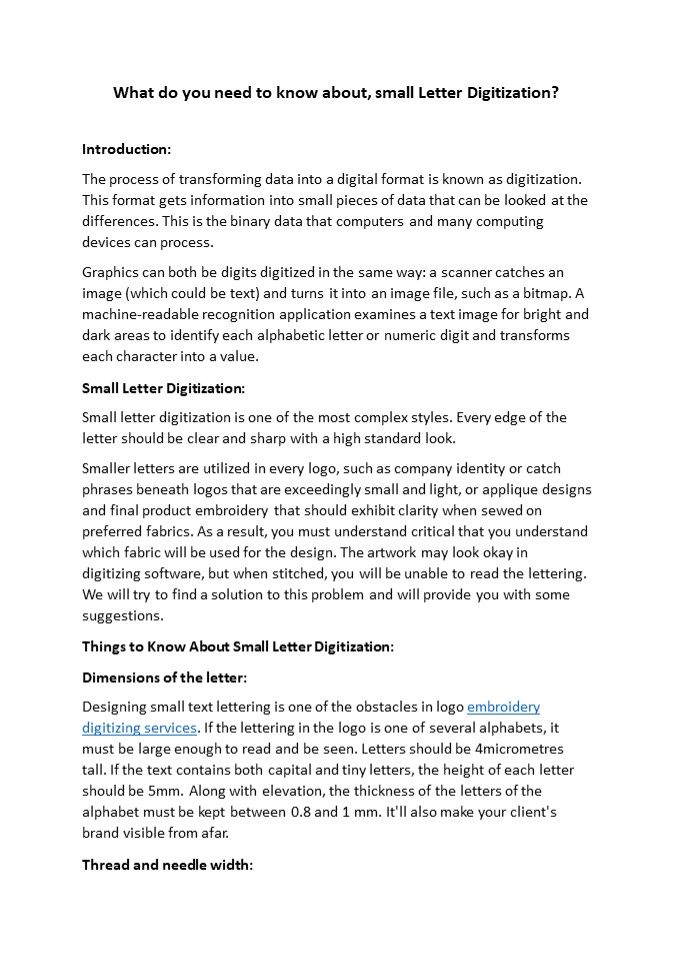What do you need to know about, small Letter Digitization? - PowerPoint PPT Presentation
Title:
What do you need to know about, small Letter Digitization?
Description:
Designing small text lettering is one of the obstacles in logo embroidery digitizing services. If the lettering in the logo is one of several alphabets, it must be large enough to read and be seen. Letters should be 4micrometres tall. If the text contains both capital and tiny letters, the height of each letter should be 5mm. Along with elevation, the thickness of the letters of the alphabet must be kept between 0.8 and 1 mm. It'll also make your client's brand visible from afar. – PowerPoint PPT presentation
Number of Views:2
Title: What do you need to know about, small Letter Digitization?
1
What do you need to know about, small Letter
Digitization? Introduction The process of
transforming data into a digital format is known
as digitization. This format gets information
into small pieces of data that can be looked at
the differences. This is the binary data that
computers and many computing devices can
process. Graphics can both be digits digitized in
the same way a scanner catches an image (which
could be text) and turns it into an image file,
such as a bitmap. A machine-readable recognition
application examines a text image for bright and
dark areas to identify each alphabetic letter or
numeric digit and transforms each character into
a value. Small Letter Digitization Small letter
digitization is one of the most complex styles.
Every edge of the letter should be clear and
sharp with a high standard look. Smaller letters
are utilized in every logo, such as company
identity or catch phrases beneath logos that are
exceedingly small and light, or applique designs
and final product embroidery that should exhibit
clarity when sewed on preferred fabrics. As a
result, you must understand critical that you
understand which fabric will be used for the
design. The artwork may look okay in digitizing
software, but when stitched, you will be unable
to read the lettering. We will try to find a
solution to this problem and will provide you
with some suggestions. Things to Know About
Small Letter Digitization Dimensions of the
letter Designing small text lettering is one of
the obstacles in logo embroidery digitizing
services. If the lettering in the logo is one of
several alphabets, it must be large enough to
read and be seen. Letters should be 4micrometres
tall. If the text contains both capital and tiny
letters, the height of each letter should be
5mm. Along with elevation, the thickness of the
letters of the alphabet must be kept between 0.8
and 1 mm. It'll also make your client's brand
visible from afar. Thread and needle width
2
It is preferable to use a smaller needle and
thinner thread for custom embroidery digitizing
services. The letter will be smaller as the
needle becomes smaller. Conversely, when the
thread becomes thinner, the letter becomes
smaller. We must understand the meaning of the
numbers assigned to threads. String number
thinner than thread number 40. When a 60-weight
thread is used for digitizing, the letters are
smaller than when threading no. Forty is used.
Nevertheless, the size of the needle and thread
is not the essential criterion for a flawless
alphabet. Size of the font The size and fonts of
the letters are the most important thing in
letter digitization If the font and size cannot
be used by the customers design. Can be
modified in needed. Selecting the Best
Underlay Underlay is necessary to assure a
sturdy foundation for your lettering to stitch
on. Nevertheless, as with so many other things in
this life, more of a good thing could be
dangerous. It also is essential that you do not
utilize underlay. Optimize stitching and textile
intensity The best embroidery patterns are those
that keep the stitch and fabric density
consistent. With practice, you'll realize that
the thread density should match the fabric used
to sew the letters on. When using high-density
density stitches on light-weight cloth, the
letters will not be stitched properly, and the
edges will seem sharp. Conclusion Embroidering
text is difficult in any situation, and the
smaller the font, the more difficult it is to
keep it looking great. There are numerous
techniques for improving your digitization
method, but the harsh reality is that time and
experience are the two most crucial aspects in
creating outstanding text. Take your time, try
various tactics, and remember that you are not
alone. This has happened to all of us. Also
Read What Benefits do You Get From Professional
Embroidery Digitizing Services?































